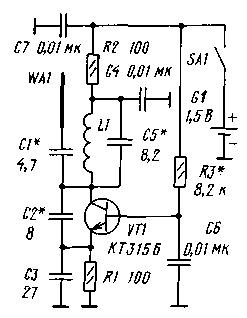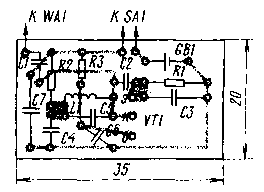
|
|
ENCYCLOPEDIA OF RADIO ELECTRONICS AND ELECTRICAL ENGINEERING Forget-me-not transmitter. Encyclopedia of radio electronics and electrical engineering
Encyclopedia of radio electronics and electrical engineering / Civil radio communications The description of the "Forget-Me-Not" set - a receiver and a transmitter that ensures the safety of a suitcase, bag, umbrella, etc., left somewhere, was published in the October issue of the Radio magazine last year. The article aroused considerable interest from readers. The "security" theme, judging by the editorial mail, continues to excite our readers. The solution to this problem proposed by the author of the article published here is ingenious in its simplicity, since it does not require the manufacture of a special receiver. True, the reliability of the described device, which monitors the disappearance of the carrier frequency of a microtransmitter, is not very high, but, undoubtedly, in some cases it will be quite acceptable. Like Yu. Vinogradov's Forget-Me-Not, the proposed device consists of two parts: a transmitter and a receiver; only the receiver is used ready, on any VHF band. The transmitter operates at a fixed frequency and continuously emits a low-power RF signal, and the receiver receives it. However, near (0 ... 2 m), due to the fact that the signal level is relatively high, the automatic gain control (AGC) system of the receiver closes the preliminary stages and it does not emit any sound. When the transmitter is removed, the field strength level at the receiving point drops, the AGC opens the amplification stages, and noise is heard in the dynamic head, signaling the loss of the item.
The transmitter (Fig. 1) is a simple but stable single transistor oscillator. Power supply - one galvanic cell from a wrist electronic watch with a voltage of 1,5 V, current consumption - 2 mA. Operation is maintained when the supply voltage drops to 0,9 V and can reach 10 hours. By selecting capacitor C5, the generator is tuned to a free section of the range. The receiver can be used with any pocket receiver with FM band (88...108 MHz) or VHF band (65,8...74 MHz). The printed circuit board of the transmitter is shown in fig. 2. The device uses resistors of the MLT-0,125 type, capacitors C1, C2, C5 - KT1, the rest - KM. Toggle switch SA1 - PD9-2 from calculators, power supply G1 - an element of any type (better than a larger capacity) from an electronic watch. Antenna WA1 - flexible wire MGSHV-0,2 or MGTF-0,14, about 15 cm long. Coil L1 is wound on a mandrel with a diameter of 2,4 mm with PEV-2 0,71 wire and contains 17 turns. The battery is soldered to the board, for which its conclusions must be cleaned and coated with phosphoric acid. To set up the transmitter, you need a regulated power supply, an oscilloscope with a bandwidth of up to 100 MHz, or an RF voltmeter. Capacitors C1, C2 and C5 are replaced with trimmers of the KT4 type with a capacity of 1,9 to 15 pF, and the resistor R3 is replaced with a trimmer resistor with a resistance of 22 kOhm and a constant resistor of 1 kOhm connected in series. The transmitter is connected to an adjustable power source and the voltage is set to 1,5 V. The wire from the antenna must be connected to the input of an oscilloscope or an RF voltmeter. By rotating the sliders of the tuning elements, it is necessary to achieve the generation of a sinusoidal signal on the antenna. If there is no generation, you can try to pick up the resistor R1. An RF voltmeter will help you estimate the voltage at the antenna in the absence of an oscilloscope. Then the supply voltage is reduced to 0,9 V, while the signal amplitude gradually decreases. If the generation failed, it is necessary to select the resistor R1; it may be necessary to select capacitors C2 and C3. The transmitter must work stably over the entire range of supply voltage changes. The next step is the final setup. The tuning elements are replaced with constants of close nominal value, the devices are turned off, the regulated power source is changed to a galvanic cell and the receiver is turned on at a free frequency, the one that will become the operating frequency of the system. By selecting capacitor C5, the transmitter frequency is adjusted so that noise disappears in the receiver. Then carry the receiver at a distance of about 3 m from the transmitter. If the noise does not disappear, adjust the level of radiated power by selecting the capacitor C1 and the length of the antenna WA1. At the end of the adjustment, the board is wrapped with insulating tape, and then with copper foil, which is soldered to a common wire. This is necessary so that during the operation of the product, adjacent parts of the body do not affect the setting. Author: R. Balinsky, Kharkov, Ukraine; Publication: N. Bolshakov, rf.atnn.ru
Artificial leather for touch emulation
15.04.2024 Petgugu Global cat litter
15.04.2024 The attractiveness of caring men
14.04.2024
▪ Smart watch with a living organism inside ▪ Terrestrial bacteria could have gone to Mars ▪ Nostalgia reduces physical pain ▪ Innovative water purification system
▪ Telephony site section. Article selection ▪ article Steamboat with a candle. Tips for a modeler ▪ What were the stages of the decomposition of the primitive communal system? Detailed answer ▪ article Deputy Head of the Logistics Department for Production Issues. Job description ▪ article Clearance lights of aliens. Encyclopedia of radio electronics and electrical engineering
Home page | Library | Articles | Website map | Site Reviews www.diagram.com.ua |






 Arabic
Arabic Bengali
Bengali Chinese
Chinese English
English French
French German
German Hebrew
Hebrew Hindi
Hindi Italian
Italian Japanese
Japanese Korean
Korean Malay
Malay Polish
Polish Portuguese
Portuguese Spanish
Spanish Turkish
Turkish Ukrainian
Ukrainian Vietnamese
Vietnamese


 Leave your comment on this article:
Leave your comment on this article: